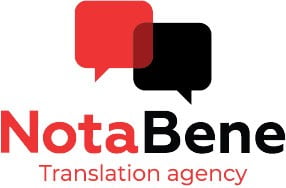Order translation from Finnish or into Finnish at NotaBene Agency in Warsaw and Gdansk!
NotaBene Translation Agency is an experienced supplier of translation from Finnish into Polish and vice versa for any documents or texts.
What types of texts does NotaBene Translation Agency work with?
– Technical translation from Finnish — we translate any texts in electronics, aviation and shipbuilding, agriculture, industry, oil and chemistry, etc. For this purpose, we pick translators who understand the specific nature of a given industry.
– Translations for the IT sector from and into Finnish for the localization of applications, games, software and websites.
– Medical translation from Finnish — books, manuals, articles in specialized printed and online publications, clinical records, correspondence with medical institutions, transcriptions and translations of test results, instructions for medicines and many other types of texts. This kind of translation requires flawless knowledge of medical terminology and focus on detail to rule out ambiguity, because the result can affect the health or life of many people.
– Legal translation from Finnish: statutes, registration deeds, articles of incorporation, contracts, powers of attorney, court records and many other similar documents.
– Financial translation from Finnish: this type of translation includes the translation of balance sheets, tax returns, payment invoices, waybills, tender documents, etc.
– Literary or fiction translation from Finnish of fiction, marketing and advertising materials. Unlike the previous types of translation, in this case there is more room for a translator’s creativity, because there is no need for “word for word” translation. The most important thing is that the translated material produces the same impact as the original, while an excellent translation may even make it better.
Please note that the translation mentioned is certified by an agency seal only. If you need sworn translation, kindly notify your manager in advance. Sworn translation is possible only for certain languages.
How to have a translation from Finnish into English, Polish, Russian, Belarusian or Ukrainian?
First of all, you need to order it. To do so, send your source text and specify your requirements for the translation from Finnish. A customer service specialist at the Nota Bene Translation Agency will prepare a ToR based on the specific features of the order. If the project involves more than one job, a unique glossary is created to ensure the consistency and proper use of terminology.
An entire team of several professionals normally works on the translation from Finnish: a translator, proofreader, editor, quality controller, layout designer and manager who will be available during working hours. In order to rule out human errors, the translation agency uses modern services to check punctuation, idioms, numerical expressions, and formulas. The material is also reviewed by the chief editor.
Confidentiality of translated data is ensured by a special NDA, whenever a customer wishes to have one. Documents can be delivered to any country.
We very rarely apply additional fees for “urgency” or “specialized subjects”, so you can be sure that the price will not rise when the project is delivered. It is true that in rare cases, such as “we need to have it yesterday” instances, and when a customer is willing to pay a higher rate for the team to work outside normal working hours, at night or on weekends, the fee might be increased, but this is always negotiated with the customer in advance.
Amazing facts about the Finnish language
Finnish (Suomi) is one of the 24 official languages of the European Union. It is not a widespread language, but it is a very unusual and very interesting one. Perhaps that’s why in recent years the interest to this language among foreign students is rising.
1. Finnish belongs to the Baltic-Finnic subgroup of Finno-Ugric languages. It is remarkable for its ancient roots: it is thought that the original language from which Finnish comes was already spoken one thousand to one and a half thousand years before Christ. The language of Suomi began to form around the beginning of our era. It was then that it gradually began to stand out from the other Baltic dialects.
2. The vast majority of Finnish speakers live in Finland. Quite large Finnish-speaking diasporas exist in Sweden and Norway. Small Finnish communities also live in Russia, Estonia and the USA. It is estimated that Finnish is spoken by about 5-7 million people.
3. Finnish can be seen as a very simple language at first sight. There are no articles, there is no grammatical gender (even “he” and “she” are referred to by one word, “han”) and no future tense. Such sounds as “g”, “sh”, “ch”, “z” are absent, “f” is rare (and only in loanwords). There is no problem with the stress – it always falls on the first syllable. All letters are always and everywhere read as they are written.
4. But we shouldn’t think that Finnish language is too simple. The features described above are compensated by the enormous number of cases – there are 15 of them. Moreover words are always inflected, with special case endings for each case, plural and singular. To top it all off, there are 36 different tense forms of verbs. So there is a lot to learn, Finnish is obviously harder than even Hawaiian.
5. There are 8 vowels and 17 consonants (4 of them are used exclusively in words of foreign origin). However, all vowels have short and long phonemes (a-aa, e-ee, o-oo, u-uu). Many words differ from each other only by the length of the vowel. For example, tapan (I killed) and tapaan (I met).
6. In Finnish language vowels are used almost as much as consonants, whereas many other languages use consonants more intensively. As a consequence the Finnish language is exceptionally melodious. Legend has it that J.R.R. Tolkien based his Elvish language on Finnish.
7. The longest really used Finnish word is lentokonesuihkuturbiinimoottoriapumekaanikkoaliupseerioppilas – 61 letters. It stands for assistant to a junior mechanical officer in the Finnish Air Force specialising in jet aircraft turbines. But it is by no means a record. Since Finnish is an agglutinative language, it allows for really long words. For example, the longest by far is kumarreksituteskenteleentuvaisehkollaismaisekkuudellisenneskenteluttelemattomammuksissansakaankopahan – 102 letters. It means something abstract, disorganised, perhaps even non-existent, carrying something negative in itself. It is impossible to translate it precisely into other languages.
8. Many words in Finnish have a very interesting etymology. So the word poikamies (bachelor) consists of the words poika (boy) and mies (man). In other words, a man who never gets married is still a boy. The name of October is lokakuu, a word formed from loka (mud) and kuu (month).
9. Quite interesting is also the etymology of the word Perkele, frequently used by Finns, “devil”. Originally Perkele was a name of the thunderer god in the Karelian-Finnish mythology (Perkunas in the Baltic region, Perun in the Slavs). Subsequently, after the Christianisation of Finland, churchmen made every effort to demonise members of the old pantheon of gods.
We have been in business for over 20 years and during that time we have learned to work well. Trust us with your translation from Finnish and get a great result at a reasonable price!








